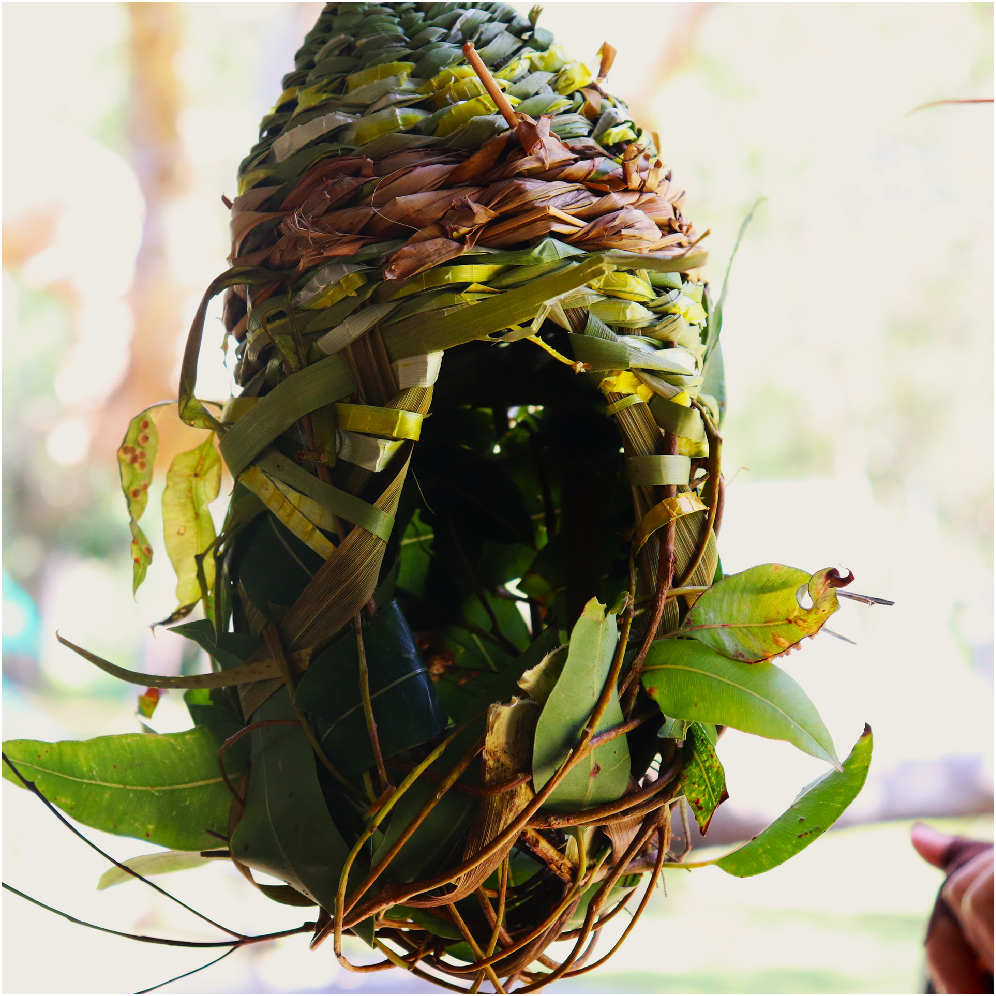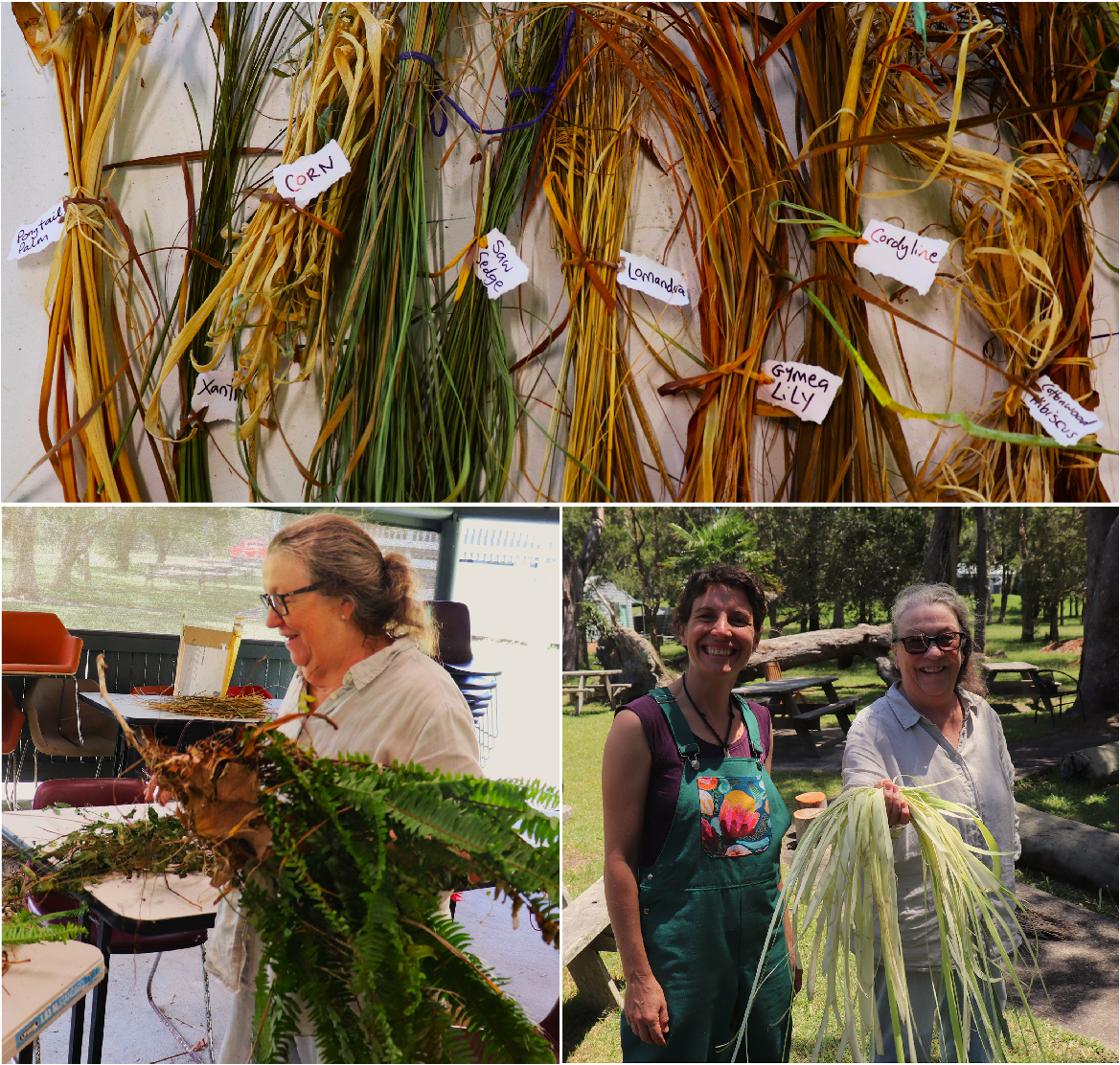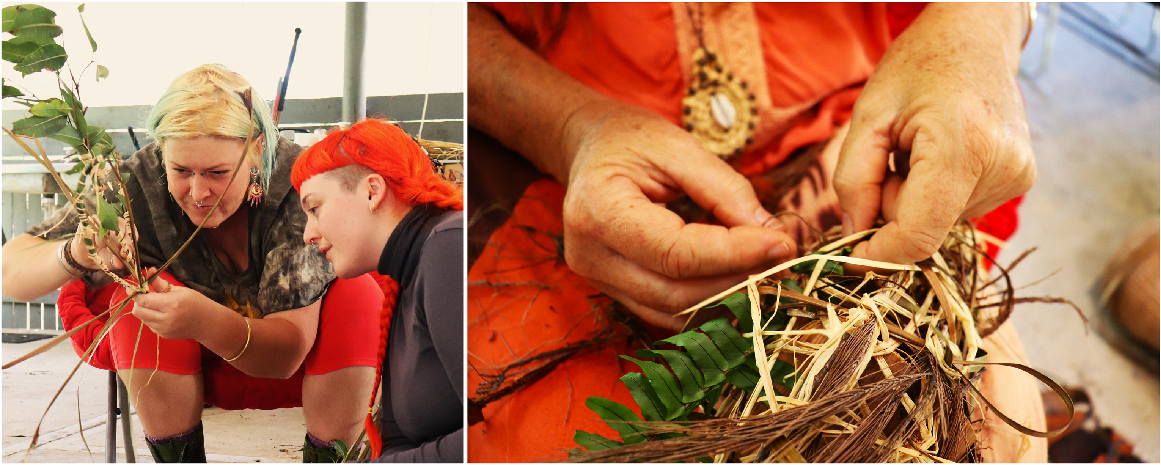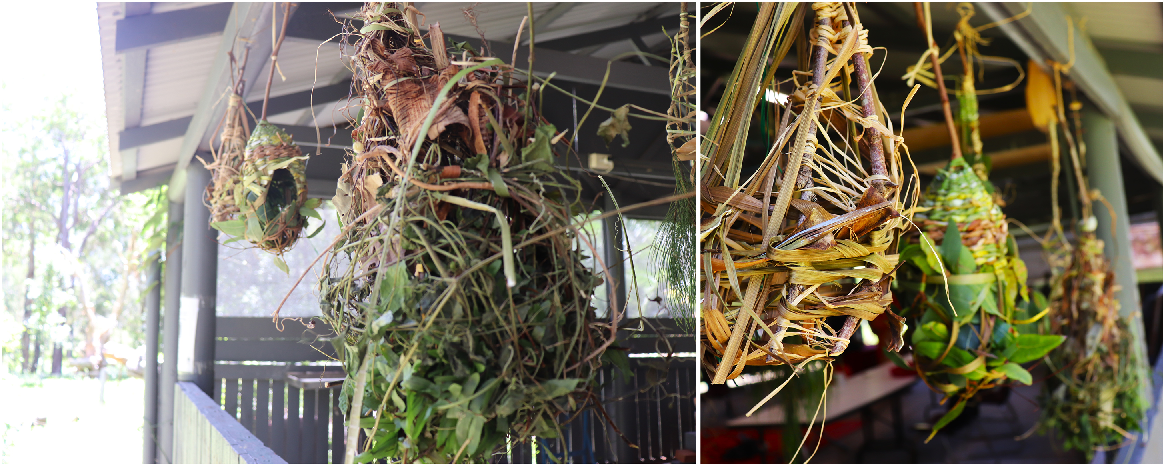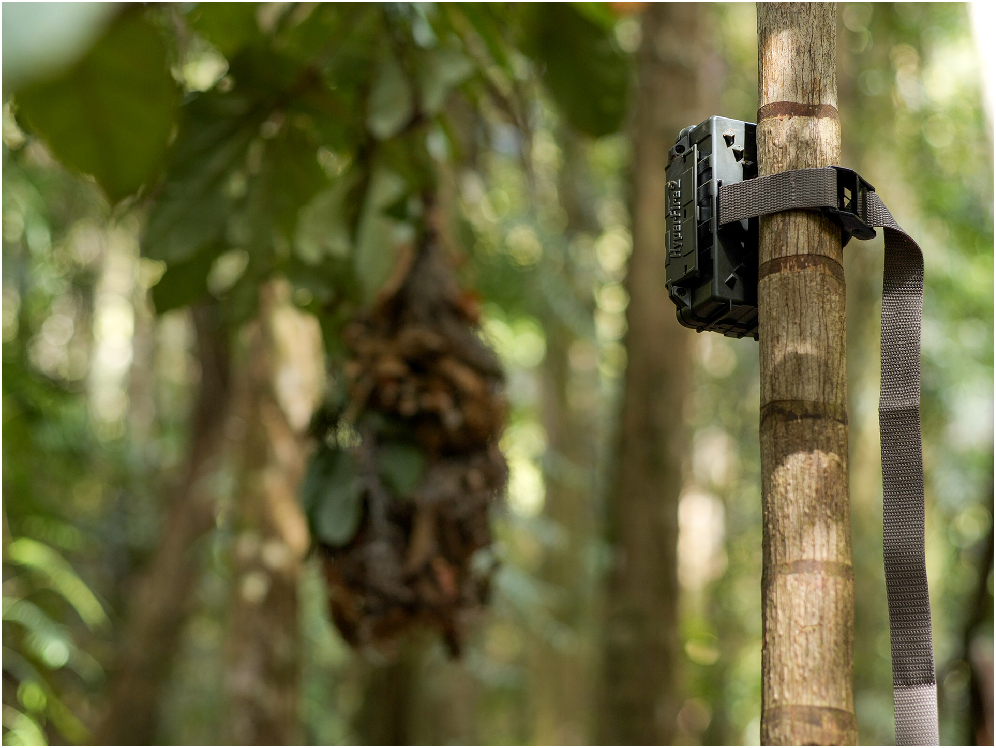Girrimarring wiirrilgal bulany ngayanbading (bat nest-type fur sun-like): blending traditional knowledge and western science to create roosting habitat for the threatened golden-tipped bat Phoniscus papuensis
Anna Lloyd A , Alicia Scanlon A , Lilly Clegg B , Ruth Link C , Lauren Jarrett C , Kristy Pursch D * , Alison Williams B and Melissa Giese A
A , Alicia Scanlon A , Lilly Clegg B , Ruth Link C , Lauren Jarrett C , Kristy Pursch D * , Alison Williams B and Melissa Giese A
A
B
C
D
Abstract
Despite being widely distributed along eastern Australia, the golden-tipped bat (Phoniscus papuensis) is listed as Vulnerable in New South Wales (NSW). The 2019–2020 wildfires affected an estimated 40% of foraging and roosting habitat, causing further conservation concern. The species roosts in suspended birds’ nests located along watercourses in rainforest or wet sclerophyll forests. Habitat augmentation is a key recovery action for the species; however, effective techniques are unknown.
We integrated western scientific and Indigenous cultural knowledge and practice to deliver an artificial roosting structure for golden-tipped bats, and designed and implemented a collaborative model for habitat restoration, with genuine opportunity for cultural practice and two-way knowledge sharing.
In partnership, members of Indigenous groups, western scientific organisations and volunteers shared learnings about bats, culture and caring for Country. Weaving materials were collected from local forests, roosts were woven and hung in rainforest gullies and monitored using remote cameras and direct visual inspection.
Golden-tipped bats used woven roosts, suggesting that roosting-habitat augmentation could support recovery of the species. Strong partnerships were established between government conservation programs and local Indigenous communities, engaging younger generations in cultural practice and learning. Delivery models were demonstrated for further collaborative, two-way threatened species projects.
Golden-tipped bats will use woven structures for roosting. Integrating Indigenous knowledge into threatened species programs can deliver effective conservation outcomes for specialist and cryptic species.
Should further broadscale fire, or other impact causing loss of roosting structures occur, community, Indigenous groups or government agencies can utilise this model to implement effective conservation actions together.
Keywords: artificial roosts, bushfire recovery, caring for Country, First Nations, golden-tipped bat (Phoniscus papuensis), Gumbaynggirr Country, Gumbaynggirr Nation, habitat augmentation, Indigenous collaboration, Indigenous conservation, Indigenous culture, Indigenous knowledge, insectivorous bats, microbats, suspended birds’ nests, traditional owner.
Introduction
The golden-tipped bat (Phoniscus papuensis; Fig. 1a) is a threatened species of insectivorous bat that is listed as Vulnerable in New South Wales (NSW). It is distributed along the eastern coast of Australia in scattered locations, reaching north-eastern Victoria (L. Lumsden, pers. comm.) in the south of its range, and in the north, extending into Cape York Peninsula and Papua New Guinea (Churchill 2008; ABS 2024). The species has been recorded in a variety of forest types, mostly from rainforest gullies and adjacent wet and dry sclerophyll forest (Law and Chidel 2004), including disturbed regrowth eucalypt forest (Parnaby and Mills 1994).
(a) A golden-tipped bat (Phoniscus papuensis) captured in the Richmond Range area of New South Wales (NSW). Characteristic golden-tipped fur assists this species to camouflage with its diurnal roost to avoid detection (source: George Madani). (b) A yellow-throated scrub-wren (Sericornis citreogularis) nest suspended over a waterway on the mid-northern coast of NSW, Australia. Golden-tipped bats (Phoniscus papuensis) roost by day within the loose fibres of the bases of these nests, where they are perfectly camouflaged from predators and protected from diurnal conditions (source: Anna Lloyd/DCCEEW).
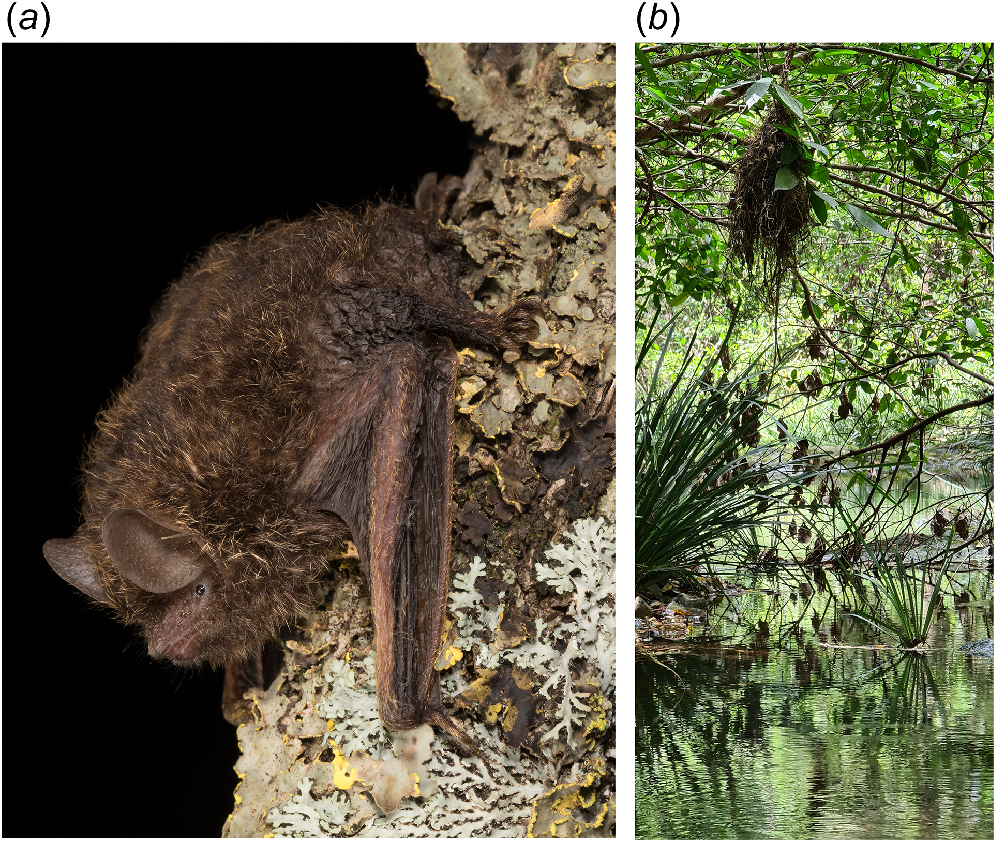
Golden-tipped bats mainly roost in suspended nests of the yellow-throated scrub-wren (Sericornis citreogularis; Fig. 1b) and brown gerygone (Gerygone mouki) (Schulz 1995; Madani et al. 2022) found in rainforest gullies on small first and second-order streams. The species will also roost in hollows within rainforest trees (Schulz 2000a), within epiphytic moss or, less commonly, in clumps of foliage (Law and Chidel 2004). Yellow-throated scrub-wren and brown gerygone nests are constructed by the birds, using dry twigs, moss, fine leaves and other organic material. The structures typically hang from smaller branches, affording their occupants refuge from predators such as snakes or goannas. Individual golden-tipped bats use several roosts located within rainforest habitat and close to creek lines, moving frequently among roosts (Law and Chidel 2004). Individual golden-tipped bats will use roosts that are typically within 100–200 m of each other but have been recorded using roosts located 800 m apart (Law and Chidel 2004).
Golden-tipped bats forage almost exclusively on species of orb-weaving spiders (Schulz 2000a), which they pluck from webs with slow and manoeuvrable flight (Rhodes 1995) afforded by their short and wide wings (Aldridge and Rautenbach 1987). Golden-tipped bats forage in rainforests but also in adjacent mid- to upper slopes containing a broad range of sclerophyll forests (Schulz 2000b; Law and Chidel 2004).
High-severity fire and impacts on rainforest and golden-tipped bats
The location of rainforest communities in moisture-retaining gullies and south-facing slopes generally reduces fire activity and intensity in these areas (Bradstock et al. 2010; Godfree et al. 2021) and can even cause fires to extinguish under favourable conditions (Wood et al. 2011; Collins et al. 2019). Soil moisture is high, combustible fuel loads are low and the vegetation is often less flammable than in eucalypt forests on mid- to upper slopes or on north-facing sunny aspects (Crockett et al. 2006; Alexander and Arthur 2014). Rainforest-dependent species are often mal-adapted to fire, and under typical fire weather and behaviour, species such as the golden-tipped bat can be protected or minimally affected because of reduced fire intensity and spread into these areas (Wood et al. 2011; Collins et al. 2019).
In 2019–2020, Australia experienced megafires that were unprecedented in their size and number (Nolan et al. 2020), affecting over 5 × 106 ha in NSW (Collins et al. 2021; DCCEEW 2024), and 10.4 × 106 ha of land across south-eastern Australia (Godfree et al. 2021). In NSW, 1.5 × 106 ha of the burn area was subject to high-severity fire, which in some locations penetrated areas of rainforest (Collins et al. 2021). The likely cause of these widespread and high-severity fires was an extended and severe preceding drought, combined with extenuating adverse fire weather, both being unprecedented in the documented record up to 2019 (Squire et al. 2021). High-severity fire entering rainforest will change the overall vegetation structure (Crockett et al. 2006), with implications for resident fauna through reduced shelter and prey availability and increased exposure to elements and predators.
Post-fire modelling across the known distribution of the golden-tipped bat indicates that 40% of suitable golden-tipped bat habitat was affected by the 2019–20 fires (Lloyd and Pennay 2021). The affected areas included rainforest gullies used by roosting golden-tipped bats and adjacent areas of sclerophyll forests on mid- to upper slopes, where golden-tipped bats forage for orb-weaving spiders. The impact of the 2019–20 fires on the roosting habitat and behaviour of golden-tipped bats was extensively studied across its NSW distribution (Law et al. 2022a, 2022b; Madani et al. 2022). Researchers found that suspended birds’ nests, such as those made by yellow-throated scrub-wrens and brown gerygones, were readily consumed by fire and were in lower abundance in gullies burnt by moderate to extreme fires. The reduction of suspended bird nests was proposed as one of the reasons for the low post-fire occupancy of golden-tipped bats documented in rainforest gullies that were burnt or surrounded by areas affected by fire (Law et al. 2022a, 2022b; Madani et al. 2022).
As an initial, emergency response to the loss of key habitat features, Madani et al. (2022) undertook a limited trial to augment roosting habitat for golden-tipped bats. On the basis of anecdotal observations of successful, opportunistic roosting by golden-tipped bats in household cloth mop heads, 60 mop heads were deployed in unburnt and burnt golden-tipped bat habitat. This was a low-cost, low-complexity approach to determine whether golden-tipped bats would accept artificial roosting structures. Monitoring did not detect roosting golden-tipped bats in these structures; however, high rainfall and flooding post-fire scoured vegetation at some sites and damaged the mop structures. Nevertheless, these trials triggered our interest in exploring alternative methods for augmenting roosting habitat for golden-tipped bats.
Habitat augmentation
Habitat augmentation is a tool in conservation management designed to increase habitat suitability or correct for loss of specific habitat requirements of a species. Artificial refuges are a form of habitat augmentation that aim to provide human made structures for animals to shelter in when natural refuges have been depleted or lost. Artificial refuges come in many forms and include bird and bat boxes, solitary bee and wasp hotels, artificial dens and hollows, artificial reefs and spawning substrates for aquatic species. They have been used in the conservation and management of a range of species with mixed results, and can be manufactured from both natural and synthetic materials (Rueegger 2016; Taylor et al. 2019; Cowan et al. 2021; Watchorn et al. 2022).
Some fauna species are reluctant to use artificial refuges or are challenging to cater for, including many species of insectivorous bat (Griffiths et al. 2017; Rueegger et al. 2019). For those species documented to use artificial bat roosting habitats, uptake can take many months and knowledge on how to cater for specific species is limited (Griffiths et al. 2017; Rueegger et al. 2019). The golden-tipped bat presents a unique challenge because of its specific use of suspended birds’ nests as shelter and roosting habitat. The structure and composition of nests is difficult to replicate by using human-made materials, but may be more achievable by using natural materials and traditional weaving techniques.
Indigenous knowledge in conservation co-design
Threatened species recovery and natural resource management programs that are co-designed with or led by Indigenous knowledge holders are delivering positive and often unique outcomes for threatened species (Read and Ward 2011; Marsh et al. 2015; Hausheer 2017; Paltridge and Skroblin 2018; Lindsay et al. 2022; Skroblin et al. 2022; Goolmeer and van Leeuwen 2023). Such programs have helped conservation efforts for Warru (black-footed rock-wallaby, Petrogale lateralis centralis), dugong (Dugon dugon), Mankarr (greater bilby, Macrotis lagotis), the great desert skink (known by various Indigenous names, Liopholis kintorei), Ngaṉamara or Gnow (malleefowl, Leipoa ocellata) and even endangered ecosystems such as the Monsoon Vine Thickets of the Dampier Peninsula.
First Nations Peoples are custodians of specific knowledge about species, their behaviour and ecology, and their participation in threatened species recovery programs can achieve critical outcomes for cultural practice and management of Country, while also delivering economic benefits for communities (Lindsay et al. 2022; Goolmeer and van Leeuwen 2023). Even though the inclusion of Indigenous knowledge in threatened species conservation projects is increasing, there remains enormous scope for greater participation and partnerships. Collaborative, ‘two-way’ approaches provide opportunities to combine western scientific and Indigenous knowledge and practice to solve threatened species management challenges, invariably with better outcomes for species and lasting outcomes for Indigenous communities (Skroblin et al. 2021).
The significant loss of golden-tipped bat roosting habitat following the 2019–20 wildfires provided a unique opportunity for western scientists, who were responsible for the NSW Government’s conservation recovery program for the species, to partner with local Indigenous communities in the co-design and delivery of practical solutions to support persistence of the species in the wild.
Materials and methods
Study location
This study was undertaken on the lands of the Gumbaynggirr Nation, focussing on coastal areas between Corindi and Nambucca Heads on the NSW mid-northern coast (Fig. 2). Gumbaynggirr Country meets its northern Bundjalung and Yaegl neighbours at the mouth of the Clarence River, near Yamba. To the south at the Nambucca River, Gumbaynggirr meet Dunghutti clans. To the west towards Guyra, Gumbaynggirr People meet the Gamilaraay.
Locations of project partners, woven-roost deployment areas, surrounding public lands and golden-tipped bat records.
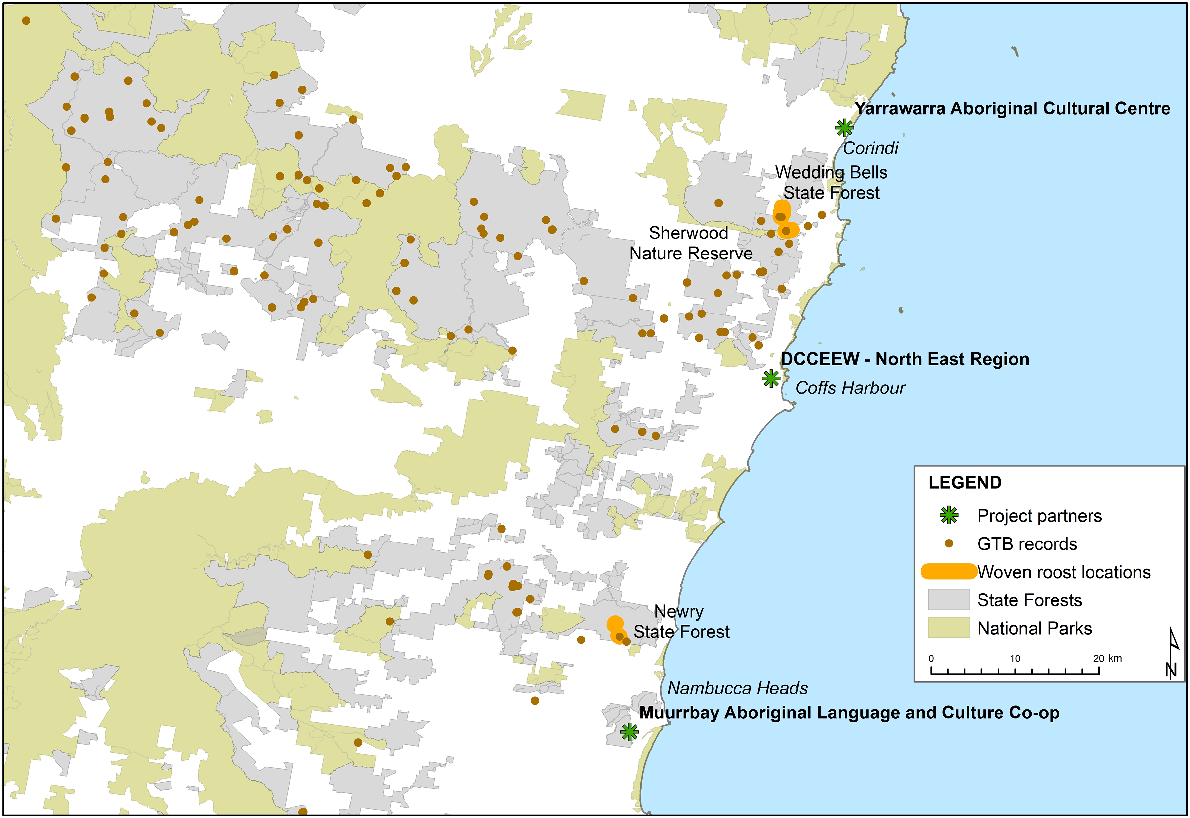
Within Gumbaynggirr Country, the project was delivered in partnership with two community groups at two locations. Muurrbay Aboriginal Language and Culture Co-operative (Muurrbay) ran weaving sessions at Bellwood Mission and installed woven roosts on Country in adjacent Newry State Forest (Nambucca area). Yarrawarra Aboriginal Cultural Centre (Yarrawarra) ran weaving sessions at Corindi and installed woven roosts on-Country in the nearby Sherwood Nature Reserve and Wedding Bells State Forest.
Project partnerships and delivery model
The project was coordinated by a team from the NSW Department of Climate Change, Energy, the Environment and Water (DCCEEW), including threatened species staff with expertise in insectivorous bat ecology, conservation and recovery, and Indigenous staff and trainees who were able to help identify knowledge holders within the Gumbaynggirr Nation and support the development of collaborative partnerships. The DCCEEW team secured project funding, attended to all scientific and animal ethics approvals and permits (Forestry Corporation Research Permit 100204, NSW DCCEEW ARA 200901/02), and delivered culturally appropriate presentations and training sessions on western scientific understanding of the golden-tipped bat, including ‘hands-on’ opportunities for participants to see and handle disused yellow-throated scrub-wren nests.
The partnership model involved formally engaging project managers, artists, linguists, weavers and other cultural experts from the two local Indigenous community groups to co-design and help deliver the project. Muurrbay (Fig. 3) and Yarrawarra (Fig. 4) delivered their projects independently from each other; however, DCCEEW project participants were able to maximise sharing of information and learning across the program. The delivery model was flexible enough to respond to unforeseen barriers, opportunities and any changes to needs and capacity within communities.
(a) Muurrbay participants and leaders, pictured with DCCEEW insectivorous bat ecologists. (b) Weaving by Muurrbay was led by master weaver Aunty Lauren Jarrett (source: Kristy Pursch/DPIE).
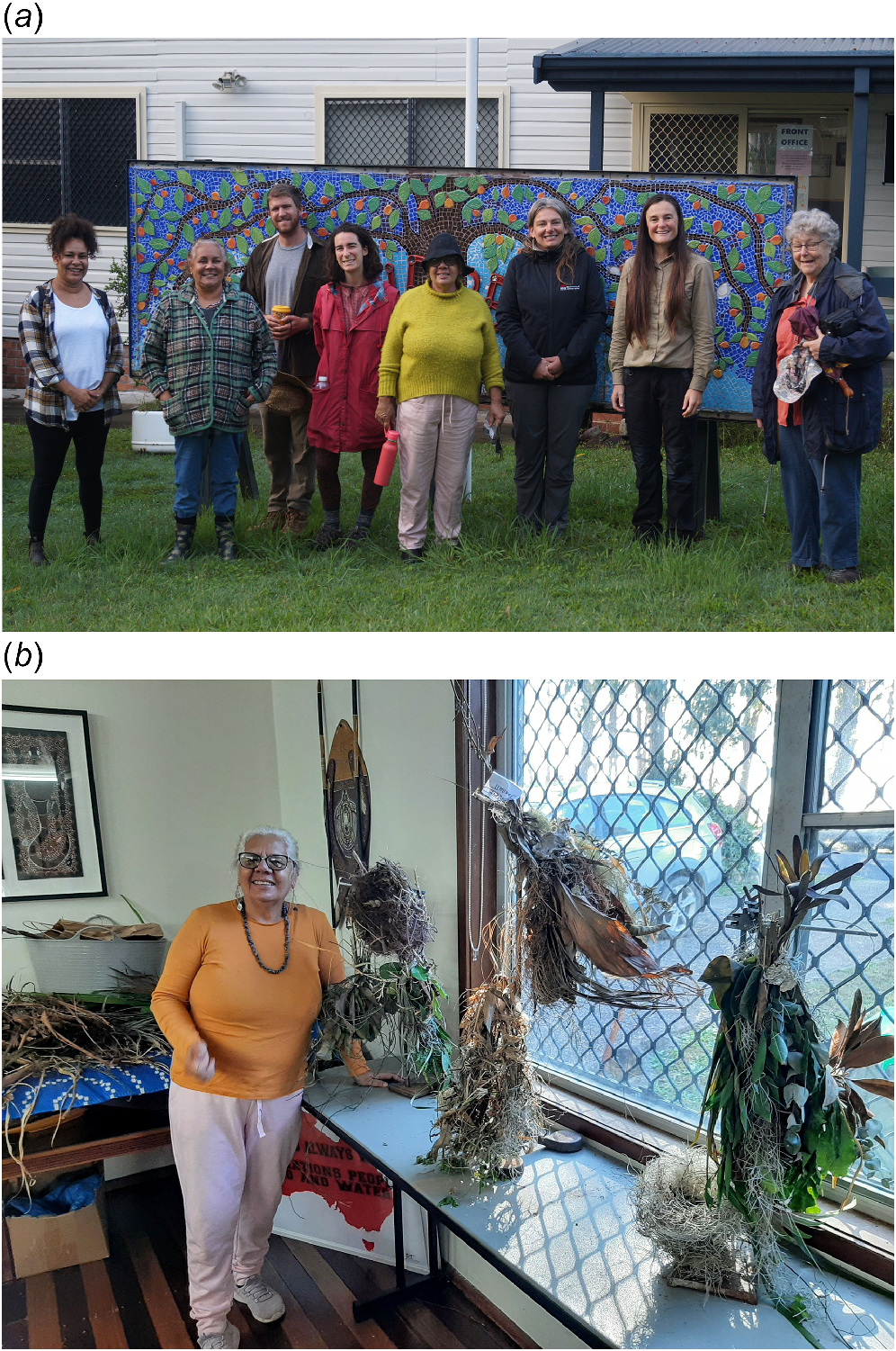
Yarrawarra leaders and participants, with weaving lead by Lilly Clegg, pictured in the centre of the group (source: Kristy Pursch/DPIE).
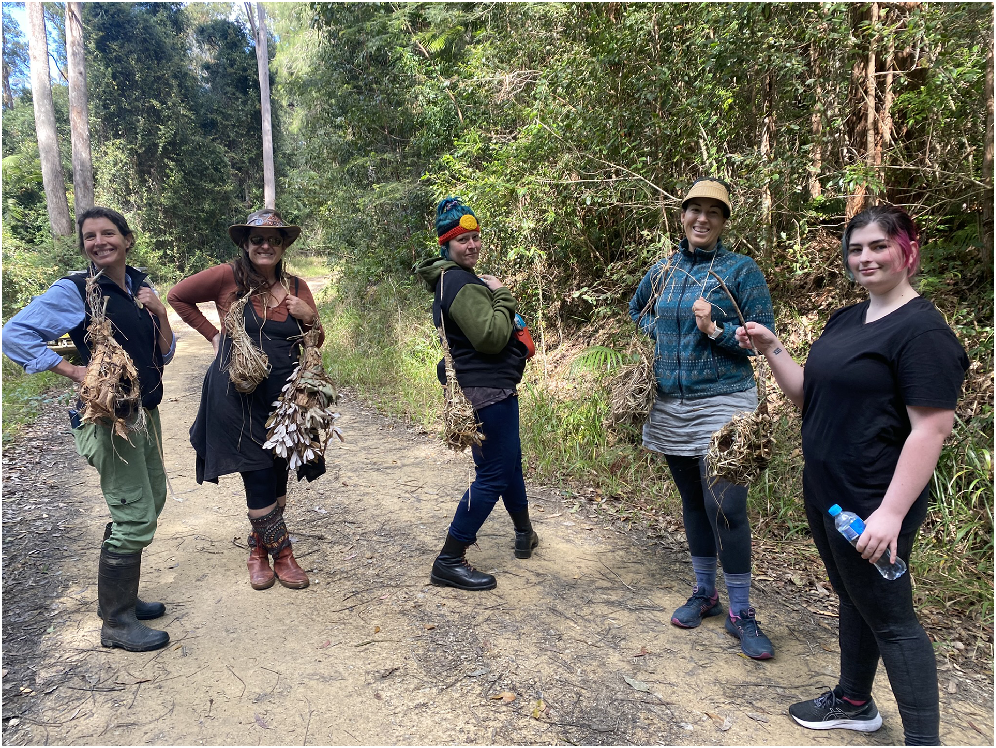
The program commenced in March 2022. Both Muurrbay and Yarrawarra prioritised participation from Indigenous members of the community, but also extended invitations to non-Indigenous local community members. Muurrbay also chose to deliver the project to students at Nambucca Heads High School during 2022 and 2023, and Yarrawarra included students from Woolgoolga High School in 2023.
One of the earliest actions under the program was for Muurrbay and Yarrawarra project staff and the DCCEEW team to present information to participants on the ecology and habitat of the golden-tipped bat and outline why creating artificial roosts can support golden-tipped bat recovery following habitat loss from events such as severe wildfires. Muurrbay, Yarrawarra and DCCEEW staff conducted a day on-Country, allowing participants to identify and collect suitable weaving materials under the guidance of weavers from the two community groups. With the assistance of DCCEEW staff, the groups also explored golden-tipped bat habitat, located and examined yellow-throated scrub-wren nests and observed DCCEEW staff conducting golden-tipped bat surveys, including demonstrations of insectivorous-bat capture techniques.
The DCCEEW team then supported both Muurrbay and Yarrawarra to plan and host a series of weaving days over a 12-month period to design and create woven roosts. Muurrbay project staff also visited Nambucca Heads High School every month for a period of 6 months to guide students in traditional weaving practices and the selection and preparation of suitable weaving materials. To celebrate the end of the first year of the program, Yarrawarra hosted a public exhibition of the woven roosts at Wadjar Regional Indigenous Gallery (refer to Supplementary material S1). This also provided an opportunity to provide information to the community on golden-tipped bat conservation and the collaborative recovery program.
Both Muurrbay and Yarrawarra elected to deliver the second year of the program (2023–2024) through a series of shorter, more intensive weaving sessions targeted at high school students. Yarrawarra project partners wove nests with Woolgoolga High School students over five 2-h sessions in August and September 2023. DCCEEW staff supported this work with an introductory presentation on golden-tipped bats at the school and an on-Country day at Sherwood Nature Reserve to explore golden-tipped bat habitat, locate yellow-throated scrub-wren nests and demonstrate insectivorous-bat survey techniques. At the same time, Yarrawarra project staff provided instruction on the identification and collection of suitable weaving materials. At the completion of all weaving sessions, when the roosting structures were finalised, students returned to Sherwood Nature Reserve with DCCEEW staff and Yarrawarra to install the woven roosts. Box 1 contains a direct account from Yarrawarra’s golden-tipped bat Project Officer, Lilly Clegg, on the steps involved in weaving the roosts.
| Box 1.Direct account from First Nations weaver Lilly Clegg |
|
In September 2023, Muurrbay project partners elected to host a 2-day bat camp on-Country with students from Nambucca Heads High School. This involved a master weaver, Muurrbay’s Golden-tipped Bat Project Officer, Community Elders, teachers from Nambucca Heads High School and DCCEEW project staff. Students explored golden-tipped bat habitat, located yellow-throated scrub-wren nests, observed insectivorous bat survey techniques and were guided by the master weaver in identifying and collecting suitable weaving materials. The students then wove roosts under the instruction and guidance of the master weaver, Muurrbay project officer and Nambucca Heads High School Aboriginal Support Officer.
Roost deployment
Project partners, weavers and students were all involved in the deployment of woven roosts to suitable locations on-Country in September or October each year, ahead of the summer golden-tipped bat breeding season. Areas chosen needed to be easily accessible (preferably by two-wheel drive vehicle), requiring limited walking and avoiding areas with heavy vegetation, steep slopes or other physical hazards. Rainforest gullies with records of golden-tipped bats were identified and ground-truthed by DCCEEW staff prior to deployment. Woven roosts were deployed in clusters of three to five, spaced 100 m or more from the next, nearest cluster. It was thought this might assist golden-tipped bats to locate woven roosts and mimicked the natural distribution of yellow-throated scrub-wren nests in the forest. Fig. 2 shows roost-deployment locations.
Roosts were hung along permanent streams or ephemeral drainage lines that carried water only during rain or wetter times. Initially, first- and second-order streams were targeted; however, for logistical and access purposes, larger third- and fourth-order streams were also used. Roosts were hung at heights of 1.75–2.5 m, by using 1 mm gauge black-coated wire in a manner mimicking natural pendulous yellow-throated scrub-wren nest positioning. As such, woven roosts were typically suspended from the ends of smaller branches that could support the weight of the woven structure, but which would yield readily under the weight of predators such as rodents, snakes or goannas. Flora species were not considered important for the selection of hanging locations, but generally comprised of riparian trees such as small-leaved lilly pilly (Syzygium luehmannii) or water gum (Tristaniopsis laurina). Roosts were preferentially hung in shaded areas over water to provide a suitable microclimate with high humidity and moderate ambient temperature. Locating woven roosts along drainage lines and over water would also allow for the natural removal of guano (bat faeces) from below the roost by running water. All the woven roosts, during both seasons, were placed in areas where golden-tipped bats had been recorded previously.
Roost monitoring
Woven roosts were monitored using 8–10 covert trail cameras (Reconyx HF2X Hyperfire 2; Fig. 9) set on a selection of roosts at each of three locations (Newry State Forest, Sherwood Nature Reserve and Wedding Bells State Forest). Cameras recorded still and video images of nightly activity, with the resulting imagery being downloaded, and batteries checked/changed monthly. Camera settings were configured for the greatest sensitivity and targeting configuration for insectivorous bats, while maintaining full-time monitoring of any activity associated with the roosts. Settings used included the following: motion picture On, pictures per trigger 10, picture interval Rapidfire, motion video On, video length 5 s, dynamic video Off, quiet period No Delay, sensitivity Very High, motion schedules 24 Hour and PIR type High Frequency. Cameras were placed on the nearest tree and angled upward towards the base of the woven nest they were set to monitor. Timber stakes or metal star pickets were not used to place the cameras closer to the nests because of risk of floods and disturbance to creek beds. Combinations of roosts and adjacent trees were chosen that would provide the shortest distance between the roost and the camera. Distances between roosts and cameras were between 3 and 5 m.
Camera monitoring was supplemented for the duration of the program with monthly inspections by DCCEEW staff, occasionally accompanied by project partners. Inspections were conducted using a torch and burrow scope (where necessary) during daylight hours when a roosting bat might be in residence. Care was taken to not touch the hanging roost during monitoring to avoid disturbing potential residents. Most frequently, a torch was used to investigate the base of the woven roosts and any side gaps or crevices that could host a bat. Rarely, the burrow scope was used when the roost was too high to check confidently with a torch. Checking the roosts with a thermal camera was trialled but found to be ineffective. Photographs of the woven roosts were taken during each site visit to record their persistence and structural integrity over time.
Results
For the duration of the 2-year project, the two community groups and two high schools remained fully engaged. More than 60 members of the community (Indigenous and non-Indigenous), and over 50 high school students (Indigenous and non-Indigenous) participated in weaving workshops, on-Country field days, yarning days and presentations about the golden-tipped bat and woven roost installations. Eight on-Country field days were conducted to support learning about the golden-tipped bat and its habitat, harvest weaving materials and deploy roosts. In addition, DCCEEW staff spent a further 12 days monitoring roosts over the two seasons. In total, 68 woven roosts were deployed, 37 within Newry State Forest and 31 across Sherwood Nature Reserve and Wedding Bells State Forest. Monthly monitoring was conducted over a 4-month period between October 2022 and January 2023 and over a 7-month period from October 2023 to April 2024.
Connecting Indigenous knowledge and western science
During project inception meetings, Uncle Gary Williams from Muurrbay gave a Gumbaynggirr name to the project; ‘Girrimarring wiirrilgal bulany ngayanbading’. This translates in English as ‘Bat nest-type fur sun-like’.
The western science perspective delivered by DCCEEW staff took the form of culturally appropriate presentations and informal discussions about the golden-tipped bat and its ecology at stakeholder and community meetings. This included sharing information about roost requirements for the species. DCCEEW staff also provided disused yellow-throated scrub-wren nests to project partners for examination and use as reference material. Museum specimens of golden-tipped bats were borrowed from the Australian Museum and were available for examination by project participants. Western scientific knowledge about golden-tipped bats was presented visually and verbally in an accessible form to community members not usually exposed to scientific presentations. Groups discussed ecological terminology and methods of ecological investigation. Reference books about bats and images of golden-tipped bat research were shared. Many participants were unfamiliar with golden-tipped bats, although most knew about insectivorous bats and had personally observed them in their local area. All participants had a strong desire to support recovery of the species by providing woven roosts in their local forests.
It was an intention that DCCEEW staff attend weaving sessions in an ad hoc fashion, ensuring that the project partners had the opportunity to lead and own this aspect of the project within their communities. An important outcome was that the ownership of the weaving group, woven roosts and their design was clearly attributed to Indigenous peoples’ skills and knowledge.
Master and experienced weavers led weaving activities from which woven roosts were created. For most participants, this provided first-time exposure to a traditional Indigenous skill. In addition to passing on weaving skills, other cultural insights were shared, including knowledge of native plants, sustainable harvesting practices, native plant uses and preparation for use in weaving. Connection with the younger generation through the high school program was highly valued by Indigenous project partners.
Woven roost deployment and use by golden-tipped bat
In total, 37 roosts woven through the Muurrbay partnership were deployed in Newry State Forest in September 2022 and October 2023. In total, 16 roosts produced through our Yarrawarra project partners were deployed in Wedding Bells State Forest in September 2022, and another 15 in Sherwood Nature Reserve in September 2023.
In Sherwood Nature Reserve, the woven roosts were suspended over a larger fourth-order stream and in flatter topography than the creeks at the other sites. At the time of deployment, this site contained only a small number of disused, naturally existing suspended birds’ nests. By contrast, the creeks at Newry State Forest were narrower and contained more complex vegetation structure with smaller flyways. They ranged from second- to fourth-order drainage lines. At Wedding Bells State Forest, the creeks were similar in size but with less complex vegetation structure (larger flyways) than that of creeks in Newry State Forest and ranged from first- to third-order drainage lines. Deployment creeks at Newry and Wedding Bells contained a higher number of existing suspended birds’ nests than did those at Sherwood. At all creeks in all sites, the presence or amount of water changed over time, as was noted during roost monitoring.
Most of the roosts deployed in 2022 remained in place by April 2024, although by October 2023, at least half had lost a considerable proportion of their biomass and were no longer suitable as artificial refuges for golden-tipped bats.
No bats of any species were captured entering or leaving woven roosts on the covert trail cameras, despite setting the cameras to the most sensitive response possible. Although the cameras did not detect bats using the roosts, they detected two bats flying beneath and around a cluster of four woven roosts at Newry State Forest in January 2024. Cameras also recorded the following species investigating the roosts, which would have been missed if only direct human observation was used: fawn-footed melomys (Melomyes cervinipes), brush-tailed possum (Trichosurus vulpecula) and Lewin’s honeyeater (Meliphaga lewinii). Direct human observation undertaken incidentally while servicing the cameras also identified a brown gerygone nesting in one of the woven roosts, and evidence of bird nesting activity in one of the first-year roosts at the Wedding Bells (deployed in 2022). A single, unidentified bat was observed flying between three clusters of woven roosts in Newry State Forest soon after dusk in September 2022.
For the first 4 months of the second season, there was no evidence, either from camera monitoring or inspections, that golden-tipped bats were using the structures. However, during a monthly check in February 2024, two golden-tipped bats were observed roosting together in a woven nest installed at Sherwood Nature Reserve 5 months previously (Fig. 10). A return visit on the following day, again found two bats in the same roost. A further visit was made on the third day; however, no bats were found in any of the roosts at Sherwood Nature Reserve. In March 2024, two golden-tipped bats were again observed roosting together in a different woven roost at Sherwood Nature Reserve. No follow-up checks were made to reduce disturbance. In April 2024, three golden-tipped bats were observed roosting in yet another, different woven roost at Sherwood Nature Reserve. These bats were observed over three consecutive days and were filmed exiting this roost (Fig. 11, Supplementary material 1). No monitoring was undertaken in May 2024. In June 2024, none of the woven roosts were occupied by golden-tipped bats. All roosts recorded as being used by golden-tipped bats (Fig. 12) were deployed in October 2023. As individual bats were not marked in any way, we cannot determine how many individual bats, in total, have made use of the roosts.
Roosting golden-tipped bats observed in a woven roost made for this program (source: Alicia Scanlon/DCCEEW).
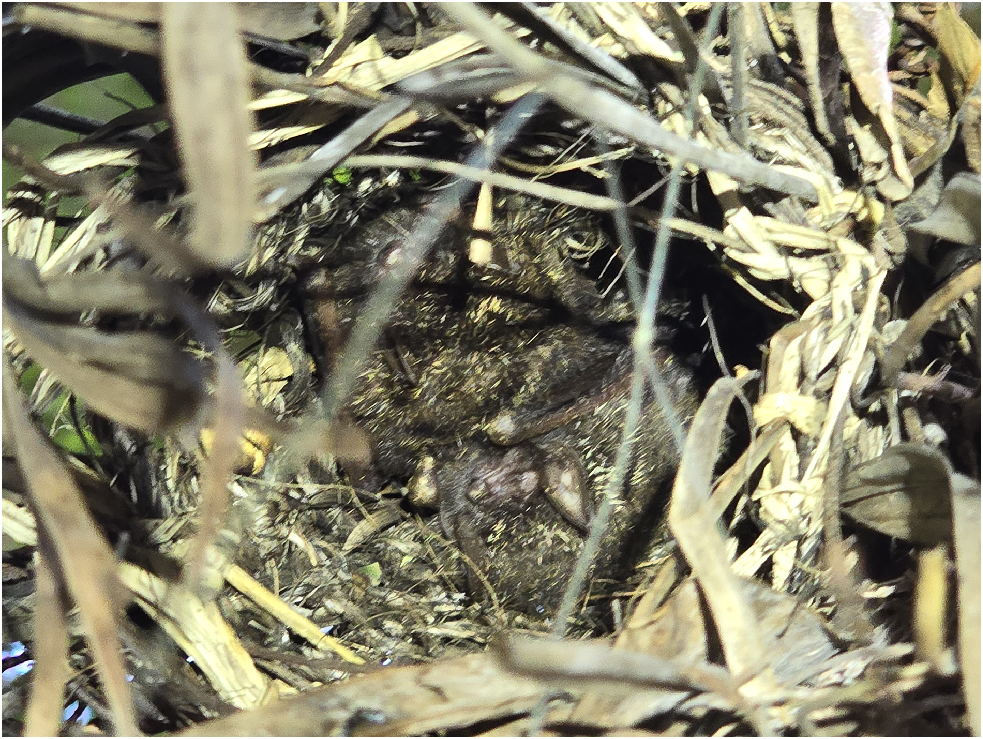
An image from film taken of the golden-tipped bats existing a woven roost. A QR link to the video is provided in the Supplementary material 1, or, alternatively, the video can be sourced here (source: Alex Pike/DCCEEW).
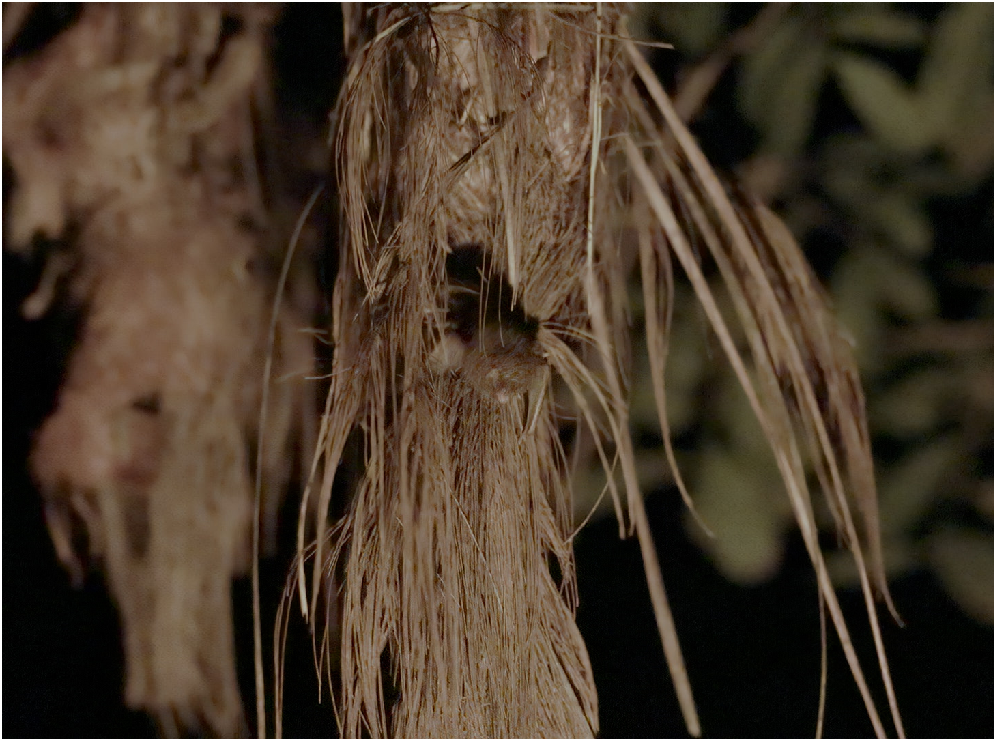
Community engagement, education, and project promotion
A project like this relies heavily on the willingness of community volunteers to engage and participate in the weaving and creation of woven roosts. Project partners and DCCEEW staff promoted the project on their respective social media pages and websites, posted flyers about the project within their local communities and wrote newsletter articles about the project to generate interest prior to project commencement. Social media posts, webpages and newsletters were also updated throughout the project. A recording of the golden-tipped bats emerging from a woven roost was taken under red lighting and shared with our Muurrbay and Yarrawarra project partners and on DCCEEWs You Tube channel (refer to Supplementary material 1).
Key actions that kept participants engaged for the duration of the project were regular direct face-to-face interactions with project partners, the community of weavers and DCCEEW staff, exposure to the broader context of the project through on-Country days and involvement in woven roost installation. A project video was also produced, to further promote the project (refer to Supplementary material 2).
Following the completion of the 2022 weaving period and during the 2022–23 monitoring period, Yarrawarra Aboriginal Cultural Centre hosted a public exhibition titled ‘Girrimarring wiirrilgal bulany ngayan-bading’ at Wadjar Regional Gallery. The exhibition ran from December 2022 to February 2023 and included an array of woven roosts created by members of all weaving groups, plus sculptural installations of golden-tipped bats and orb-weaving spiders that were created by the community (refer to Supplementary material Fig S1). Photographic images of project partners and weavers creating woven roosts, exploring golden-tipped bat habitat on-Country, were included in the exhibition, along with text descriptions of golden-tipped bat ecology and the impact of the 2019–20 bushfires on the habitat of this species.
Discussion
This project presented the following specific question to two local Indigenous groups and sought their assistance to find a solution: can we weave roosts for golden-tipped bats to help support their recovery in the wild? In doing so, the project challenged western-trained threatened species scientists engaged to deliver a government program to explore a novel conservation outcome through genuine connection and collaboration with Indigenous people. The project documented, for the first time, the successful use by golden-tipped bats of purpose-built artificial roosting habitat in the wild. Moreover, it found a model for two-way delivery where direct action, community engagement and community education can achieve the desired results, both in terms of practical species conservation and Indigenous cultural practice.
Engagement of Indigenous community in conservation projects
The project presented both opportunities and challenges. A key opportunity was the inclusion of Indigenous and non-Indigenous school students as weavers. This created extended periods of intergenerational connection and knowledge sharing and was a key outcome for Indigenous partners. Meeting over a common goal and aspiration and sharing knowledge in a natural and non-confrontational setting mirrored the way traditional weaving practices create space and enable relationship building. This was one of the many benefits of including Indigenous knowledge into the project.
The project exposed a willingness and interest within local Indigenous communities to engage on environmental issues generally, and on threatened species conservation specifically. Community understanding of the ecology, behaviour, habitat use, threats and conservation of golden-tipped bats and other insectivorous bats was enhanced and underpinned the weaving process (see Box 2). Although not specifically measured, anecdotally, the project empowered Indigenous People to partner with Government and work towards supporting this and other threatened species in the region.
This two-way conservation project was enhanced by using creativity and art as pathways to engagement and participation. These forms of expression clearly hold a space in Indigenous knowledge and culture. For example, although the structures woven by participants needed to serve a practical, ecological purpose, the project allowed for a great deal of variation and interpretation in design. As a result, there was broad artistic expression and sculptural aesthetic in the roosts. The exhibition of the woven structures prior to being deployed also presented a new pathway to communicating about the project and the bats to a different sector of the community (artists and art lovers). The exhibition also provided a more formal and ceremonial way to bring together project participants to celebrate the project. There is an increasing interest in the role of art in science and conservation projects (Curtis et al. 2012; Jacobson et al. 2015; Harrower et al. 2018), and this project shows benefit in investment in the arts for conservation projects where a connection is clear.
Through sound partnerships, the project also achieved intangible outcomes such as increased agency for Indigenous partners. At the outset, aims and methods for the project were based on Indigenous communities making their own decisions about how to respond to the specific question of using hand-made roosts to support golden-tipped bat recovery. Indigenous partners and DCCEEW staff supported one another with their respective strengths, knowledge and experience in a collaboration that was mutually respectful and trusting. Although this generally was fluid and natural, at times discipline was required to not over-step or over-direct an outcome. For government program partners, this was a key requirement in appropriately supporting all aspects of the project.
The project also experienced some challenges, some being anticipated, whereas others were unexpected. Engagement with the wider (Indigenous and non-Indigenous) community on a conservation issue is generally approached via social media, webpages, newsletters and flyers. However, on this occasion, targeted engagement with Indigenous community members required different approaches. As the project developed, western partners learned about some of the challenges and barriers faced by Indigenous People beyond meeting daily personal and family obligations. For example, limited financial resources can prohibit people from giving time to volunteer activities, the logistics and costs of travel to and from volunteer activities can be difficult to meet, and health or other issues may limit mobility, especially for elder community members and knowledge holders when a project requires on-Country activities in untracked forest terrain.
Cultural safety of project participants needs to be prioritised to minimise the risk of culturally inappropriate or offensive behaviour from other volunteers or members of the public. This can be particularly difficult to manage across social media platforms and will require targeted and nuanced engagement across Indigenous and non-Indigenous participants and community members.
Promotion of projects such as this one within mainstream media also requires careful management. We found, for example, that particular care was needed when engaging the media to reduce the risk of unintended omissions or errors in reporting that may negatively affect partner relationships or could also affect project partners personally within their communities.
As for any project, continuity of individual participants can create challenges, but for Indigenous communities and organisations, filling gaps left behind can take longer, or roles may need to change to suit a new, incoming person with a different skill set or with different cultural relationships and knowledge.
Securing funding to support untrialed and unconventional conservation actions is a further challenge in a competitive financial environment. Funding bodies routinely favour projects that can deliver measurable conservation actions delivered using known techniques and methods. When funding is secured for innovative projects, such as the golden-tipped bat roost weaving project, resourcing can be short-term, often funding only a ‘pilot’ project. This makes it difficult to provide the certainty needed for longer-term partnerships and engagement. This project was funded through several, short-term budgets, providing limited financial security for the project and its participants, and compromising medium- to long-term project planning.
Providing space and time for listening, connecting, and sharing culture and knowledge has been important in the way this project has successfully blended Indigenous knowledge with western science. Western program-delivery models generally value high-output production, with productivity linked to pre-determined deliverables or tasks, all being achieved within structured project management frameworks and according to strict timeframes. Although it can be challenging to break away from this model and make the time and space for authentic and successful collaborations, the benefits to species conservation, partnerships and Indigenous cultural practice are significant.
Use of woven structures by golden-tipped bats
The project has produced preliminary evidence that golden-tipped bats in the wild will make use of artificial structures designed to augment habitat features in areas where they may have been depleted, such as following natural disasters such as wildfires. Further iterations of this project and resulting observations will help resolve which features make the chosen roosts successful. The three structures that are known to have been used so far all provided a well-sized, dark and weather-proof space in the base of the roosts. In one of the woven roosts that was occupied, we noted that the bats made use of a side gap that was present in the design. We also noted that these characteristics were present in other structures that have not yet been recorded as occupied. Some of the unoccupied roosts are significantly smaller, lacking in obvious entry gaps and internal chambers that bats can utilise or that may allow significant amounts of light and rain to penetrate.
During this stage of the project, golden-tipped bat use of woven roosts was able to be determined only when the bats were in residence, because golden-tipped bats leave little evidence of their presence. In the future, surface swabs of the inner parts of the woven roosts will be collected and analysed for the presence of golden-tipped bat DNA to trial if this can provide a more accurate picture of usage. So far during this project, covert trail cameras have been unable to reliably capture evidence of occupation. Achieving the right camera placement and settings to trigger an image or video of a golden-tipped bat entering or leaving a roost remains challenging in the densely vegetated rainforest setting of this project. Covert trail cameras have been used to capture images and video of insectivorous bats entering and leaving roosts in tree hollows and bat boxes by researchers on other projects (Rueegger 2017; Honey et al. 2021; Best et al. 2022; Gonsalves et al. 2024). Refinement of camera placement may improve detection rates of golden-tipped bats at woven roosts during future iterations of this project, and alternative methods to detect use of the woven structures by roosting golden-tipped bats is also planned.
Deterioration of the physical integrity of woven structures was noted 12 months after deployment. This result was expected, given that the woven roosts are constructed from natural materials that will decay and break down over time. Yellow-throated scrub-wrens refurbish their nests when they are used and it is expected that the woven roosts would require repair, replacement or supplementation on an annual basis if they were to remain in use for longer periods.
In the first season, roosts deployed at the Wedding Bells site were made with emphasis on traditional basketry weaving techniques. Some included features that replicated the detail of a natural yellow-throated scrub-wren nest, comprising an entry hole and chamber that would normally accommodate a nesting bird. Two separate nesting events occurred in these first-year nests, but no golden-tipped bats were recorded using these structures.
The three woven roosts used by golden-tipped bats were all from the second season of weaving and were located within the same creek at Sherwood Nature Reserve. Second-season roosts were less structured and more random in their weaving method and design than were first-season roosts (refer to Box 1). They also contained various forms of loose material at the base to allow room for and entry of bats and had an overall ‘bell’ structure. By the second year of the program, the weavers were mindful of accommodating a more open base, and there was less focus on replicating all the features of the bird-woven nests. The third deployment site at Newry State Forest contained woven nests created during both years of the program; however, no use by golden-tipped bats was recorded.
Searches for yellow-throated scrub-wren nests (and brown gerygone nests – although these are less obvious) at all sites where woven roosts were deployed suggested there were fewer suspended birds’ nests at Sherwood Nature Reserve than at Newry and Wedding Bells State Forests. It is possible that the lower availability of suspended bird nests played a role in golden-tipped bat uptake of woven structures at Sherwood Nature Reserve.
Bats can take a long time to start using artificial or introduced habitat features and so it is possible that over time, more woven roosts across all sites may be taken up by golden-tipped bats. Being woven of natural materials, the nests have been observed to deteriorate over time, so woven-roost longevity needs to be considered for the situation for which roosts are deployed. We plan to investigate ways to increase longevity with future weaving programs. This could include increasing the bulk of the woven roosts or incorporating alternative materials.
Conclusions
This project demonstrated that blending of Indigenous knowledge and western science can achieve solutions to complex conservation problems. We will continue to refine this model for engagement with local Indigenous groups because it holds great potential to be adapted to other conservation challenges. We plan to document the project processes so that other communities living in areas with golden-tipped bats may also assist with the provision of artificial roosting habitat and actively take part in delivering conservation actions in response to golden-tipped bat habitat loss. Our project relied on volunteers weaving the roosts, with project coordination and weaving instruction being funded through external grants. Western science inputs and monitoring were provided in-kind by staff from the NSW Department of Climate Change, Energy, the Environment and Water. Roost deployments were undertaken by volunteers, externally funded project partners and DCCEEW staff. The cost-effectiveness of weaving roosts for golden-tipped bats will depend on how the project is structured and delivered. Our implementation model provides a cost-effective method of securing artificial roosts for golden-tipped bats; however, it is reliant on significant volunteer time and in-kind time provided by Indigenous groups and NSW DCCEEW staff. Building and fostering relationships takes time, but pays dividends when projects rely on the goodwill of volunteers.
Data availability
The data that support this study will be shared upon reasonable request to the corresponding author.
Declaration of funding
The project was financially supported by the Australian Government’s Bushfire Recovery Program for wildlife and their habitat, WIRES and the NSW Saving our Species program.
Heritage statement
Anna Lloyd is Senior Threatened Species Officer with the NSW Department of Climate Change, Energy, the Environment and Water. Alicia Scanlon is a Senior Threatened Species Officer with the NSW Department of Climate Change, Energy, the Environment and Water. Lilly Clegg is a Gumbaynggirr artist and the Marketing and Events Coordinator for Wadjar Regional Indigenous Gallery, Yarrawarra Aboriginal Cultural Centre. Ruth Link was a Project Officer with Muurrbay Aboriginal Language & Culture Co-operative, she is a Gooreng Gooreng woman. Aunty Lauren Jarrett is a Gumbaynggirr elder and master weaver. Kristy Pursch is a Butchulla woman and Senior Advisor with the Department of Planning, Housing and Infrastructure, previously Aboriginal Community Engagement Officer with the NSW Department of Planning and Environment. Alison Williams is a Gumbaynggirr artist and the Marketing and Events Coordinator for Wadjar Regional Indigenous Gallery, Yarrawarra Aboriginal Cultural Centre. Melissa Giese is Senior Team Leader with the NSW Department of Climate Change, Energy, the Environment and Water.
Acknowledgements
Girrimarring wiirrilgal bulany ngayanbading is being undertaken by the NSW Saving our Species program in partnership with Muurrbay Aboriginal Language and Culture Co-operative in southern Gumbaynggirr nation and the Yarrawarra Aboriginal Cultural Centre in northern Gumbaynggirr nation. We thank the NSW National Parks and Wildlife Service and Forestry Corporation of NSW for supporting the deployment of our roosts on the lands they manage. This project was conducted on Gumbaynggirr Country. We pay respects to the Elders and custodians of this Country located on the mid-northern coast of New South Wales and thank them for generously sharing their knowledge and culture to make this project possible.
References
Aldridge HDJN, Rautenbach IL (1987) Morphology, echolocation and resource partitioning in insectivorous bats. Journal of Animal Ecology 56, 763-778.
| Crossref | Google Scholar |
Alexander HD, Arthur MA (2014) Increasing red maple leaf litter alters decomposition rates and nitrogen cycling in historically oak-dominated forests of the eastern US. Ecosystems 17, 1371-1383.
| Crossref | Google Scholar |
Australasian Bat Society (2024) BatMap. Phoniscus papuensis. Available at http://ausbats.org.au/batmap [accessed 31 March 2024]
Best K, Haslem A, Maisey AC, Semmens K, Griffiths SR (2022) Occupancy of chainsaw-carved hollows by an Australian arboreal mammal is influenced by cavity attributes and surrounding habitat. Forest Ecology and Management 503, 119747.
| Crossref | Google Scholar |
Bradstock RA, Hammill KA, Collins L, Price O (2010) Effects of weather, fuel and terrain on fire severity in topographically diverse landscapes of south-eastern Australia. Landscape Ecology 25, 607-619.
| Crossref | Google Scholar |
Collins L, Bennett A, Leonard SWJ, Penman TD (2019) Wildfire refugia in forests: severe fire weather and drought mute the influence of topography and fuel age. Global Change Biology 25, 3829-3843.
| Crossref | Google Scholar | PubMed |
Collins L, Bradstock RA, Clarke H, Clarke MF, Nolan RH, Penman TD (2021) The 2019/2020 mega-fires exposed Australian ecosystems to an unprecedented extent of high-severity fire. Environmental Research Letters 16, 044029.
| Crossref | Google Scholar |
Cowan MA, Callan MN, Watson MJ, Watson DM, Doherty TS, Michael DR, Dunlop JA, Turner JM, Moore HA, Watchorn DJ, Nimmo DG (2021) Artificial refuges for wildlife conservation: what is the state of the science. Biological Reviews 96(6), 2735-2754.
| Crossref | Google Scholar | PubMed |
Curtis DJ, Reid N, Ballard G (2012) Communicating ecology through art: what scientists think. Ecology and Society 17(2), 3.
| Crossref | Google Scholar |
Crockett J, Mackey B, Ash J (2006) The Role of Fire in Governing the Relative Distribution of Rainforest and Sclerophyll Forest: the Effects of Rainforest Vegetation on Fire Spread, Report dated 25 March 2006. School of Botany and Zoology, Australian National University. Available at https://aff.org.au/wp-content/uploads/Ash_firerainforest_final.pdf
Department of Climate Change, Energy, the Environment and Water (2024) Understanding the effects of the 2019–20 fires. (NSW Environment and Heritage) Available at https://www.environment.nsw.gov.au/topics/fire/park-recovery-and-rehabilitation/recovering-from-2019-20-fires/understanding-the-impact-of-the-2019-20-fires [accessed 6 April 2024]
Godfree RC, Knerr N, Encinas-Viso F, Albrecht D, Bush D, Cargill DC, Clements M, Gueidan C, Guja LK, Harwood T, Joseph L, Lepschi B, Nargar K, Schmidt-Lebuhn A, Broadhurst LM (2021) Implications of the 2019–2020 megafires for the biogeography and conservation of Australian vegetation. Nature Communications 12, 1023.
| Crossref | Google Scholar |
Gonsalves L, Law B, O’Loughlin C (2024) Experimental assessment of the use of auger hollows and ringbarked trees for roosting by Nyctophilus corbeni in contiguous forest and a small remnant in Northwest NSW. Poster Presentation. In ‘21st Australasian Bat Society Conference’, 17–19 April 2024, Adelaide, SA, Australia.
Goolmeer T, van Leeuwen S (2023) Indigenous knowledge is saving our iconic species. Trends in Ecology & Evolution 38(7), 591-594.
| Crossref | Google Scholar | PubMed |
Griffiths SR, Bender R, Godinho LN, Lentini PE, Lumsden LF, Robert KA (2017) Bat boxes are not a silver bullet conservation tool. Mammal Review 47(4), 261-265.
| Crossref | Google Scholar |
Harrower J, Parker J, Merson M (2018) Species loss: exploring opportunities with art–science. Integrative and Comparative Biology 58(1), 103-112.
| Crossref | Google Scholar | PubMed |
Hausheer JE (2017) Traditional knowledge helps monitor threatened bilbies on Martu Country. Cool Green Science, 17 July 2017. Available at https://blog.nature.org/2017/07/17/traditional-knowledge-helps-monitor-threatened-bilbies-on-martu-country/
Honey R, McLean CM, Murray BR, Callan MN, Webb JK (2021) Choice of monitoring method can influence estimates of usage of artificial hollows by vertebrate fauna. Australian Journal of Zoology 69, 18-25.
| Crossref | Google Scholar |
Jacobson SK, McDuff MD, Monroe MC (2015) 6. Using the arts for conservation. In ‘Conservation Education and Outreach Techniques,’ 2nd edn’. pp. 155–186. (Oxford Academic) doi:10.1093/acprof:oso/9780198716686.003.0007
Law BS, Chidel M (2004) Roosting and foraging ecology of the golden-tipped bat (Kerivoula papuensis) on the south coast of New South Wales. Wildlife Research 31, 73-82.
| Crossref | Google Scholar |
Law BS, Madani G, Gonsalves L, Brassil T, Hall L, Sujaraj A, Lloyd A, Turbill C (2022a) The impact of fire severity from the 2019 to 2020 mega-fires on roosting ecology of a rainforest-dependent bat (Phoniscus papuensis). Austral Ecology 47, 1438-1447.
| Crossref | Google Scholar |
Law BS, Madani G, Lloyd A, Gonsalves L, Hall L, Sujaraj A, Brassil T, Turbill C (2022b) Australia’s 2019–20 mega-fires are associated with lower occupancy of a rainforest-dependent bat. Animal Conservation 26(1), 103-114.
| Crossref | Google Scholar |
Lindsay M, Beames L, Yawuru Country Managers, Nyul Nyul Rangers, Bardi Jawi Rangers (2022) Integrating scientific and Aboriginal knowledge, practice and priorities to conserve an endangered rainforest ecosystem in the Kimberley region, northern Australia. Ecological Management and Restoration 23(S1), 93-104.
| Crossref | Google Scholar |
Lloyd AM, Pennay M (2021) Golden-tipped bat Phoniscus papuensis. In ‘The IUCN Red List of Threatened Species 2021’. e.T10982A22021190. (International Union for Conservation of Nature and Natural Resources) Available at https://www.iucnredlist.org/species/10982/22021190
Madani G, Turbill C, Lloyd A, Gonsalves L, Brassil T, Law B (2022) How do we sleep while our beds are burning? Impacts of the 2019–20 mega-fires on a rainforest dependent species – the Golden-tipped Bat Phoniscus papuensis. Australian Zoologist 42, 223-242.
| Crossref | Google Scholar |
Marsh H, Grayson J, Grech A, Hagihara R, Sobtzick S (2015) Re-evaluation of the sustainability of a marine mammal harvest by indigenous people using several lines of evidence. Biological Conservation 192, 324-330.
| Crossref | Google Scholar |
Nolan RH, Boer MM, Collins L, Resco de Dios V, Clarke H, Jenkins M, Kenny B, Bradstock RA (2020) Causes and consequences of eastern Australia’s 2019–20 season of mega-fires. Global Change Biology 26, 1039-1041.
| Crossref | Google Scholar | PubMed |
Parnaby H, Mills D (1994) A record of the gold-tipped bat from the escarpment forests of southern New South Wales. Australian Zoologist 29, 245-249.
| Crossref | Google Scholar |
Paltridge R, Skroblin A (2018) Threatened species monitoring on aboriginal land: finding the common ground between Kuka, Jukurrpa, Ranger Work and Science. In ‘Monitoring threatened species and ecological communities,’ 1st edn’. (Eds S Legge, D Lindenmayer, N Robinson, B Scheele, D Southwell, B Wintle) pp. 321–332. (CSIRO Publishing: Melbourne, Vic, Australia)
Read JL, Ward MJ (2011) Bringing back warru: initiation and implementation of the South Australian Warru Recovery Plan. Australian Mammalogy 33, 214-220.
| Google Scholar |
Rhodes MP (1995) Wing morphology and flight behaviour of the golden-tipped bat, Phoniscus papuensis (Dobson) (Chiroptera: Vespertilionidae). Australian Journal of Zoology 43, 657-663.
| Crossref | Google Scholar |
Rueegger N (2016) Bat boxes – a review of their use and application, past, present and future. Acta Chiropterologica 18(1), 279-299.
| Crossref | Google Scholar |
Rueegger N (2017) Artificial tree hollow creation for cavity-using wildlife – trialling an alternative method to that of nest boxes. Forest Ecology and Management 405, 404-412.
| Crossref | Google Scholar |
Rueegger N, Goldingay RL, Law B, Gonsalves L (2019) Limited use of bat boxes in a rural landscape: implications for offsetting the clearing of hollow-bearing trees. Restoration Ecology 27(4), 901-911.
| Crossref | Google Scholar |
Schulz M (1995) Utilisation of suspended bird nests by the golden-tipped bat (Kerivoula papuensis) in Australia. Mammalia 59, 280-283.
| Google Scholar |
Schulz M (2000a) Diet and foraging behavior of the Golden-tipped Bat, Kerivoula papuensis: A spider specialist? Journal of Mammalogy 81, 948-957.
| Crossref | Google Scholar |
Schulz M (2000b) Roosts used by the golden-tipped bat Kerivoula papuensis (Chiroptera: Vespertilionidae). Journal of Zoology 250, 467-478.
| Crossref | Google Scholar |
Skroblin A, Carboon T, Bidu G, Chapmnan N, Miller M, Taylor K, Taylor W, Game ET, Wintle BA (2021) Including indigenous knowledge in species distribution modeling for increased ecological insights. Conservation Biology 35(2), 587-597.
| Crossref | Google Scholar | PubMed |
Skroblin A, Carboon T, Bidu G, Taylor M, Bidu N, Taylor W, Taylor K, Miller M, Robinson L, Williams C, Chapman N, Marney M, Marney C, Biljabu J, Biljabu L, Jeffries P, Samson H, Charles P, Game ET, Wintle B (2022) Developing a two-way learning monitoring program for Mankarr (greater bilby) in the Western Desert, Western Australia. Ecological Management and Restoration 23, 129-138.
| Crossref | Google Scholar |
Squire DT, Richardson D, Risbey JS, Black AS, Kitsios V, Matear RJ, Monselesan D, Moore TS, Tozer CR (2021) Likelihood of unprecedented drought and fire weather during Australia’s 2019 megafires. Climate and Atmospheric Science 4, 64.
| Crossref | Google Scholar |
Taylor JJ, Rytwinski T, Bennett JR, Smokorowski KE, Lapointe NWR, Janusz R, Clarke K, Tonn B, Walsh JC, Cooke SJ (2019) The effectiveness of spawning habitat creation or enhancement for substrate-spawning temperate fish: a systematic review. Environmental Evidence 8, 19.
| Crossref | Google Scholar |
Watchorn DJ, Cowan MA, Driscoll DA, Nimmo DG, Ashman KR, Garkaklis MJ, Wilson BA, Doherty TS (2022) Artificial habitat structures for animal conservation: design and implementation, risks and opportunities. Frontiers in Ecology and the Environment 20(5), 301-309.
| Crossref | Google Scholar |
Wood SW, Murphy BP, Bowman DMJS (2011) Firescape ecology: how topography determines the contrasting distribution of fire and rain forest in the south-west of the Tasmanian Wilderness World Heritage Area. Journal of Biogeography 38, 1807-1820.
| Crossref | Google Scholar |


